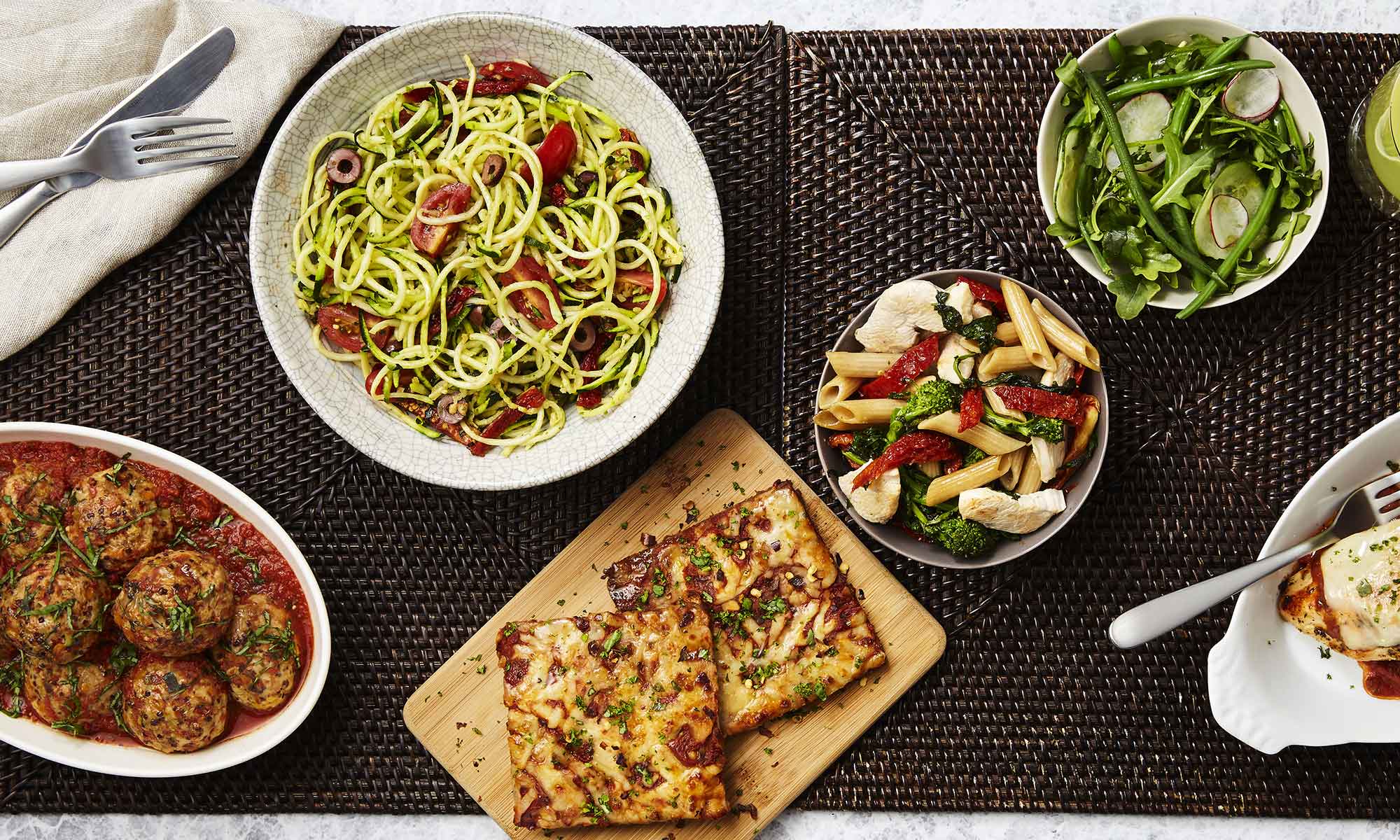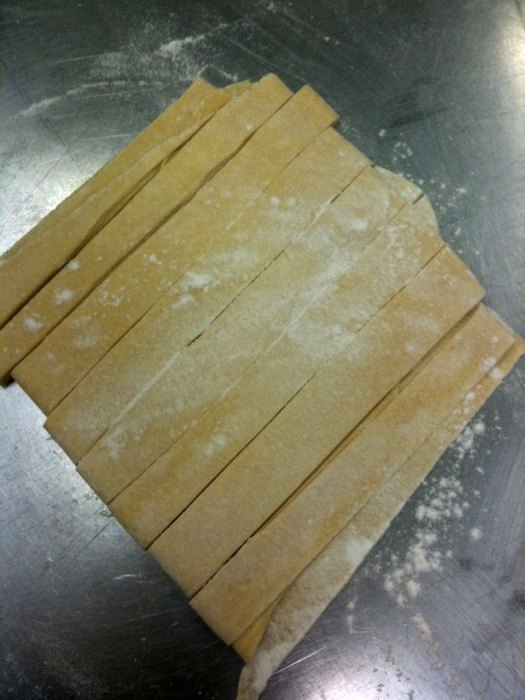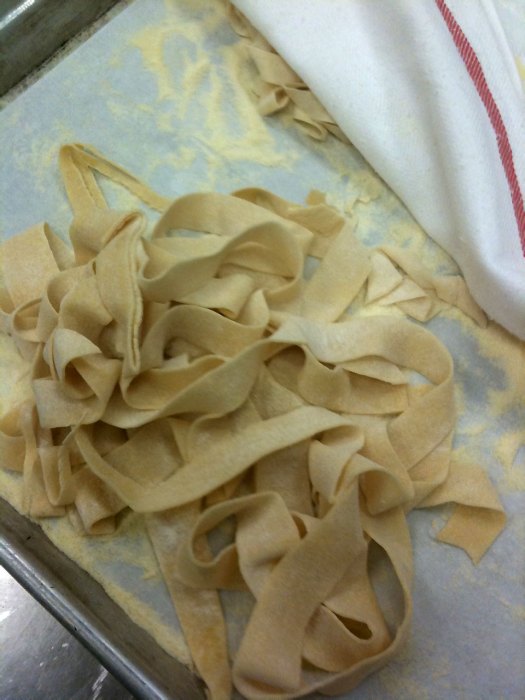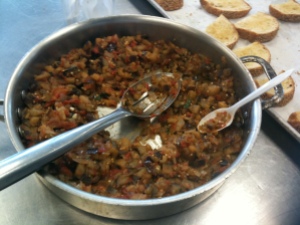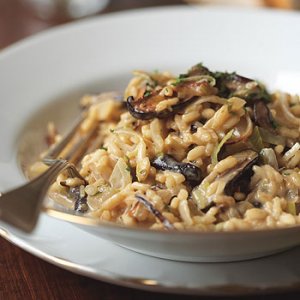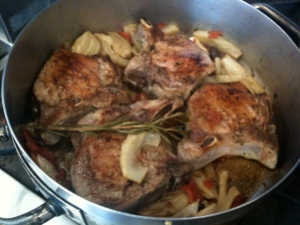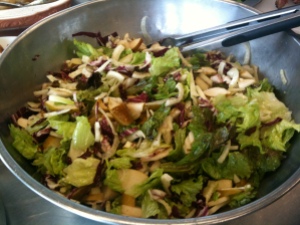Caribbean Chicken w/ Guava Pan Sauce, Caramelized Mangoes, Black Beans and Rice
Since I have lived in New York City, this has probably been the longest winter known to man. Last week on another cold, rainy, dismal day I started dreaming about going somewhere warm, sunny and tropical. Where the skies and sea are blue, the sand is white and the warm tropical air breezes through the palm trees and you don’t have a care in the world. I started having flashbacks of a trip I took to Jamaica a while back where the islanders greet you with a smile and the pace of life is laid back, jovial and carefree. One of the things I remember most about my experience there was the food and how delicious it was.
They use unique fiery blends of spices (typically Jerk which is used as a rub on grilled meats) accompanied by an abundance of tropical fruits such as citrus, bananas, mangoes, pineapple, coconuts, papaya and guava. Caribbean cuisine is a unique blend of hot and cool, savory and sweet, and a refreshing burst of flavors reflecting the tropical climates in the region.
I suddenly had a strong urge to cook a Caribbean dish and I wanted to try my new spice blend from Instant Gourmet, Caribbean Isles. This seasoning is a delicious blend of salt, bell peppers, garlic and onion, paprika and chili pepper and some additional spices – it really is great to use as a Jerk seasoning when you want some spicy flavor that isn’t too hot but very flavorful. You should try some of Instant Gourmet’s other spice blends too – they have an Original Spice blend, a Butter, Garlic and Parsley blend, a Spicy Coffee Steak blend, an Italian blend and a Southwestern Spice blend – all delicious and great on everything!
I had some chicken breasts on hand and thought I would pair it with some black beans and saffron rice as a side dish. I also wanted to experiment with some of the tropical fruits from the region and incorporate them into my dish somehow so I decided to get a mango and some guava paste to caramelize and make a pan sauce for the chicken.
I also marinated the chicken in lemon juice, garlic and parsley and used an infused lemon oil in the saffron rice to give it a nice lemony zing to round out the tropical flavors in the dish.
Traditional Jerk Chicken is usually rubbed with a dry spice blend and then grilled over hot coals to give it a crunchy blackened flavor. I decided to saute the chicken instead and make a savory pan sauce with wine, broth and guava paste to drizzle over the chicken and the rice and caramelized the mangoes by sauteing them in brown butter, brown sugar and a dash of salt and pepper. The black beans were canned (Goya brand) but to make them more flavorful, I added some sautéed onions and garlic, red wine vinegar, salt and pepper and a dash of the Caribbean Isles seasoning.
The dish turned out to be a great combination of flavors – the sweetness of the caramelized mangoes complimented the spicy savory flavors of the chicken and black beans and the lemony saffron rice gave it a fresh kick of citrus to round out the dish. It was light, refreshing and a definite departure from this dreary, rainy, cold weather city I live in, a sliver of sunshine for my day – if even for a moment.
Caribbean Chicken with Guava Pan Sauce and Caramelized Mangoes with Black Beans and Saffron Rice
1/2 cup olive oil
1/4 cup fresh lemon juice plus some lemon zest from 1 lemon
4 garlic cloves, chopped
2 tbsp fresh parsley, chopped
Instant Gourmet Caribbean Isles Spice blend
4 large skinless boneless chicken breasts
2 tbsp guava paste
1 1/2 tbsp canola oil
1/2 cup dry white wine
1/2 cup chicken broth
4 tbsp butter (1/2 stick)
1-2 tbsp brown sugar
1 large mango, halved, peeled, pitted, cut into 1/2 inch thick slices
Salt and pepper
1 package of Goya Saffron Rice (Spanish style)
1 can Goya black beans
1/2 onion, chopped fine
1 garlic clove, chopped fine
1 tbsp red wine vinegar
2 green onions, sliced fine
Whisk first 4 ingredients together to make the marinade in a large bowl. Add chicken breasts to coat. Sprinkle with salt and pepper and Caribbean Isles Spice blend on both sides. Cover chicken and chill for 2-3 hours, turning occasionally.
When chicken is done marinading, boil a pot of water and prepare the Saffron Rice per the box instructions and cook about 45 minutes until fluffy.
Remove chicken breasts from marinade, scraping excess off the chicken. Heat 1 tbsp canola oil in a heavy large skillet over medium heat. Add chicken breasts to the skillet and cook until brown, about 3 minutes per side. Transfer chicken to a plate.
Add wine and broth to the skillet along with the guava paste and stir until paste is dissolved and blended to the liquids. Bring to a boil. Add chicken breasts to the wine/broth/guava mixture in the skillet and cover, reducing heat to medium and simmer until chicken is cooked through, about 10 minutes (basting occasionally). Transfer chicken to a work surface and let stand for 10 minutes.
In a medium stovetop pan, saute some chopped onion and garlic in some canola oil until lightly browned. Add black beans (don’t drain), and 1 tbsp vinegar and a few shakes of the Instant Gourmet Caribbean Isles spice blend and a dash of salt and pepper to taste. Cook over medium heat for about 10 minutes and keep warm.
Meanwhile, melt butter in another heavy medium size skillet over medium-high heat. Add mango slices, 1-2 tbsp brown sugar, a pinch of salt and stir. Saute until browned, about 2 minutes per side.
Boil juices in skillet until slightly thickened and sauce is reduced, about 3 minutes. Drizzle guava pan sauce over the chicken breasts and serve with caramelized mangoes, black beans and saffron rice. Garnish with chopped green onions, parsley and serve with a crisp white wine.
Serves 4.
Recipe inspired by a Bon Appetit recipe for Guava-Stuffed Chicken in Tastes of the World, 2008
Find out more about Instant Gourmet spices online at www.instantgourmetspices.com
